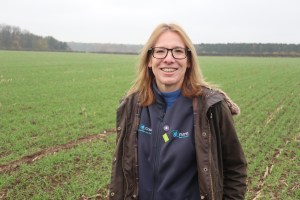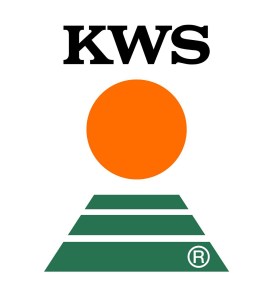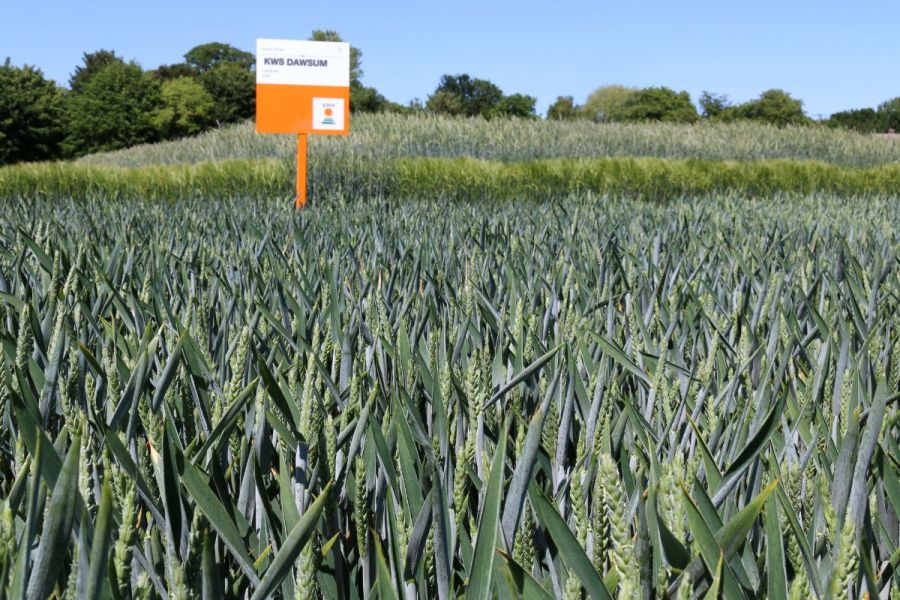Achieving sustainability requires a multi-faceted approach from farm businesses. CPM explores how growers can build resilience into their rotations over the coming years.
“Adopting the ‘marginal gains’ philosophy will be key in helping farm businesses become more resilient.”
By Charlotte Cunningham
Delivering longer terms sustainability objectives demands more forward planning than ever before and greater focus on how the years interlink to make as best use of on-farm resources as possible.

About 80% of the results seen at harvest are locked into the seed that is sown, believes Kirsty Richards.
Building resilience is often the term used to describe this approach, however, resilience means different things to different people, believes KWS’ Dr Kirsty Richards. “Nothing is a certainty anymore. We’re getting used to summer droughts in many parts of the country, and this last February was the UK’s driest for 30 years which was followed by a rainy March that was one of the wettest experienced in recent times.
“It’s impossible to plan for every eventuality in a business’ long-term planning, but building as much resilience as possible into production and finances is a good starting point.”
In production terms, this means choosing crops that will thrive in a variety of growing conditions and also make as much use of a farm’s individual resources as possible without negatively impacting them for subsequent years, she says.
“It also involves choosing management approaches that integrate across the years to complement each other, whether through creating better soil structure, reducing nutrient use or minimising energy-intensive cultivations.”
In financial terms, the focus should be on ensuring that yields and margins can be maximised and maintained so that the highest value markets can be targeted, while reducing reliance on a single market sector, through more diversified cropping, reckons Kirsty.
“Maize, sugar beet and leguminous crops such as peas and beans, for example, are all crops that can be built into most arable rotations and can make a valuable contribution in terms of management benefits and the bottom line. Financial resilience also links into effective use of individual resources, so growers are not totally reliant on costly inputs.”

Building resilience requires a holistic approach, rather than focusing on individual measures, says Allison Grundy.
But before looking at any of this, beginning to build resilience within rotations often requires a mindset shift for many, believes Allison Grundy, agronomy manager at NRM. “Resilience isn’t about doing one thing, or even a few things. It’s a whole mindset change and requires looking at a number of aspects and management decisions across the business to improve the longer-term outlook.”
Allison says, that as a baseline, it’s important to understand the limitation of the individual farming system. “These limitations might be things you can improve over time, but as a starting point it’s worthwhile allowing nature the luxury to self-organise and tap into those better functioning services without exploiting them – which ultimately is what has led to pressure on systems over the years.
“If these limitations aren’t changeable, then knowing this will help growers make better, realistic decisions – like not growing certain crops. This in turn will improve the overall sustainability and resilience of the rotation.”
From here, she advises measuring ‘the basics’, including soil organic matter and soil carbon levels. “You’ve got to get out with a spade and get all your key soil indicators analysed, like pH and soil composition. It’s boring, but true – this has got to be the starting point. Knowing your basics will help you keep an eye on how any system changes are impacting the overall farm.
“Benchmarking soil organic matter and carbon will also help identify a rotational and farm baseline to better understand and plan where actions ought to be concentrated.”
In terms of practical measures, introducing more diversity across farmland and within rotations is a key way to improve resilience, adds Allison. “More above ground diversity leads to more below ground diversity and, in turn, this leads to better soil and crop functionality.”
Improving soil carbon stocks should be a particular priority for arable farmers as NRM’s ‘CarbonCheck’ results show that these types of farms have the lowest carbon stocks – compared with livestock farmers who have the highest, she notes. “High carbon soils with low bulk density should be the goal and the reduction of bulk density can be achieved by implementing measures like straw retention, the use of organic materials and manures and reducing tillage. If you’ve got more carbon in the soil, the workability, structure and biology is better, and there is lots of data out there to back that up.”

Lower machinery costs is one of the key financial parameters that separates the top and bottom performing farmers, says James Webster.
Having a better understanding of the farm business and introducing measures to improve the baselines also offers financial rewards, explains James Webster, senior agribusiness analyst at The Andersons Centre.
A previous collaboration between Andersons and AHDB defined eight key factors that differentiate top and bottom performing farms and at the top of these was overheads. “Specifically, machinery cost is a big one where we see a lot of difference,” explains James.
Looking at data from the Farm Business Survey, the bottom 25% of farmers compared with the middle 50% had 27% higher machinery costs on average between 2017/18 and 2021/22, accounting for 31% of their revenue, he adds.
Relating this to practices in the field, bringing down machinery costs often derives around getting soils working better, says James. “If we think about better soil structure or efficient rotation planning, for example, they are both things that can be used to cut fuel costs, tyre-wear and metal wear.”
While these are arguably some of the bigger target areas, it’s also important not to overlook some of the more marginal changes, says James. “This could be the marginal cost of an extra trip with the sprayer, or fertiliser applications. An integrated pest management approach can be key here, looking at how genetics of varieties can help to reduce the need for spraying. These are relatively small changes that all add up when looking at overall costings.”
Crop-specific costs is another point of difference, with the top 25% of farmers often having lower fertiliser and pesticide usage, he adds. “Our work with AHDB also showed that the top 25% of farmers had a better understanding of the market, and from a rotation perspective this could mean that they better select crops and varieties with that end market in mind.”
So where exactly does variety choice fit into the picture and how can growers harness the power of genetics to improve and build rotational resilience?
“For us as a breeder, resilience means striving to ensure our genetics provide our customers with the best commercial opportunities possible, despite a changing future,” says Kirsty. “About 80% of the results you will see at harvest are locked into the seed that you sow. You can fine-tune this with good management, but by and large genetics dictate the overall potential of the crop.
“The characteristics of the crops you grow and the varieties you choose can also affect your carbon footprint in a way we are only just starting to understand.”
KWS’ Sowing for Peak Performance (SPP) initiative was launched in 2020 to develop varieties that can help growers cope with a diversity of growing conditions as effectively as possible. “This can be in the shape of delivering consistent yields and quality across a range of challenging growing conditions, strong physical performance in the field or robust and reliable disease resistance,” explains Kirsty.
But it’s also about encouraging growers to understand more about their individual resources and choose the right varieties to make the most of these, she adds. “High yielding feed wheats like KWS Dawsum, for example, can help spread risk and reduce growers’ carbon footprint for every tonne of wheat produced because of their exceptional output.
“A Group 2 variety like KWS Extase, with its exceptional disease resistance, can not only help growers manage their crops more effectively and widen spray windows where appropriate, it also opens up high value milling opportunities as well as bankable gains simply from its reliably high yields.
“Then there are varieties like our new spring barley KWS Curtis that, through its high alcohol extraction rates, results in 120kg less CO2 being produced for every 1000 litres of alcohol distilled compared with the variety Laureate.”
In brewing terms, KWS Curtis has a CO2 output 10% less than RGT Planet for the same hot water extract, she adds. “That’s great news for growers, alcohol producers and consumers, with the potential to produce carbon neutral beverages that everybody can enjoy with a clean conscience.
“Then there is KWS Feeris, with its BYDV resistance, that can help growers on their journey towards being insecticide free and taking advantage of current incentive schemes for this.”
High yielding hybrid ryes, like KWS Tayo, that require less water than wheat, and much less nitrogen too, and have a range of exciting new marketing opportunities opening up for them, she adds.
Kirsty believes that systems of production that are kinder to soils than current ones must be a priority in delivering greater resilience across the rotation. “Reducing compaction through excessive machinery travel is key but we will also have to focus on nutrition practices that build organic content.”

Kate Cobbold says that cover crops have a vital role to play in protecting farming’s great asset – soil.
Kate Cobbold, KWS’ oilseed and special crops manager, picks up the conversation and says that cover crops also have a vital role to play in protecting farming’s greatest asset – the soil. “Cover crops enable this by covering the soil over winter to prevent run-off and leaching and by helping to build soil structure and nutritional content within soils. Not only does this benefit the soil itself, but also the subsequent ‘cash crop’ that follows – boosting that overall rotational resilience.”
When it comes to selecting the ‘right’ cover crops, there is no one size fits all, says Kate. “What the individual farm wants to achieve from cover crops should be the key driver behind deciding what goes into the mix. It’s always worth consulting with an agronomist or even the seed supplier to better understand what the key components should be.”
Turning to weed control, more vigorous varieties that exert greater competition against weeds can reduce the requirement for heavy duty cultivations, and later drilled types can help by giving enough time to deal with blackgrass and other weed problems before they must be sown, says Kirsty. “KWS Dawsum is a good example of a variety that can be drilled in some regions from mid-September right the way through to the end of January with little yield loss, giving plenty of opportunity to drill only when the soils are in good enough condition to support it.
“Spring wheat and barley varieties have come a long way in recent years and add further options, many can be drilled in the autumn or in poor weather conditions, you can move a significant part of your drilling to the new year with the yield losses previously experienced.
“Early maturing varieties like KWS Extase can also extend the cultivation and drilling window to help you avoid having to work on land when soils are not in their best load-bearing condition.
“Soils are also critical stores of carbon and a vital component of carbon sequestration for the future. The better health they are in, the more resilient your production system will be and the varieties you choose and how you manage them can have a profound effect on this.”
Looking to the future, adopting the marginal gains philosophy will be key in helping farm businesses become more resilient, believes James. “If you make a 1% improvement to 100 different things doesn’t lead to a 100% benefit – it leads to a 168% improvement. Being resilient isn’t about making large changes in many cases, it’s the accumulation of those relatively tiny changes that are going to make the difference – and that’s what we’re seeing in some of our top performing businesses.”
Alison says that it’s important to keep the faith that although some systems changes are difficult to financially quantify, the benefits often materialise from the accumulation of margin gains. “The financial benefits grow over time – though are sometimes not recognised – through the reduction in cost of production, such as reduced inputs for example, better functioning soils and therefore workability.”
James adds that being financially better off and improving the soil and wider environment aren’t mutually exclusive – in fact, they go hand in hand. “If we look at the two biggest areas of on farm arable emissions – nitrogen and liquid fuel – they’re also two of the biggest cost centres for many businesses. So, if you can reduce emissions, there’s a good chance you can reduce costs too.”
Allison concludes: “These benefits can be for all, not just for the large estates who have the means or the pioneers, but for ‘traditional’ businesses too. In fact, it’s these businesses who have the most to gain from making, in most cases, small changes – they just have to come to the party and get involved.”
Fit for the Future
In this series of articles, CPM has teamed up for the sixth year with KWS to explore how the wheat market may evolve, and profile growers set to deliver ongoing profitability.
The aim is to focus on the unique factors affecting variety performance, to optimise this and maximise return on investment. It highlights the value plant genetics can now play in variety selection as many factors are heavily influenced and even fixed by variety choice. KWS is a leading breeder of cereals, oilseeds, sugar beet and maize.
As a family-owned business, it is truly independent and entirely focussed on promoting success through the continual improvement of varieties with higher yields, strong disease and pest resistance, and excellent grain quality. We’re committed to your future just as much as you are.
This article was taken from the latest issue of CPM. For more articles like this, subscribe here.
Sign up for Crop Production Magazine’s FREE e-newsletter here.




